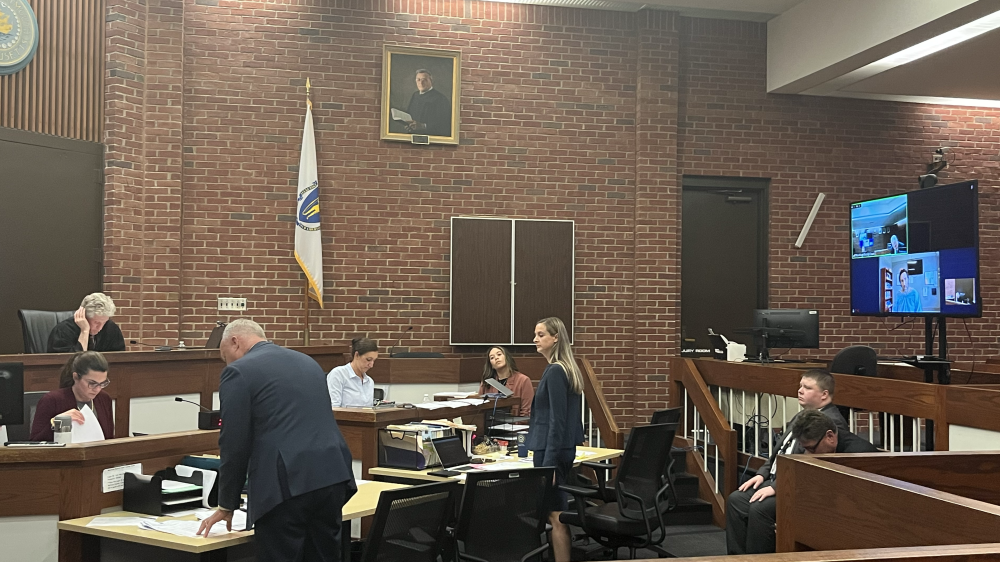Lakeville man who threatened police officers granted $10,000 bail
WAREHAM – Timothy Hladik Jr., the Lakeville man who threatened multiple police officers while armed with a “replica gun,” had his bail set at $10,000 and was granted a release under a number of conditions, including house arrest.
Lakeville and State police officers shot at Hladik on Friday, Sept. 29. In body camera footage released to the public, Hladik repeated the phrase “kill or be killed” before he was shot.
Court documents in the case against Hladik identify the two police officers as State Trooper Christopher Nees and Lakeville Police Officer Dakota Jones.
At a Wednesday, Oct. 18 dangerousness hearing, Hladik’s lawyer Joseph Krowski Jr. said that Hladik was bipolar and had not intended to harm the police officers.
“My client was experiencing a psychotic event,” Krowski said. “Certainly the ideation was suicidal, not homicidal.”
Hladik was charged with two counts of assault with a dangerous weapon, and two counts of threat to commit a crime. According to Krowski, Hladik was shot by officers approximately four times and he has since undergone surgery. The officers’ shots injured Hladik’s gallbladder, Krowski said, and he “is required to use a colposcopy bag and he did have a catheter.”
Hladik takes multiple medications for his bipolar condition and he also attends therapy, Hladik’s mother said in court testimony.
Krowski argued that the fact that Hladik’s gun was a replica was “significant.”
“I don't discount again that these two officers went through something that was probably emotional for them, but they were never in real danger,” Kowski said. “My client did not have a real gun [and] never discharged a single bullet.”
Plymouth County Assistant District Attorney Lindsay Smith characterized Hladik’s interactions with the police as being dangerous.
“Both of those officers were required to discharge their firearms using lethal force,” she said. “Anyone in the area could have been struck. Either of them could have been struck by each other and residents nearby looking out the window to see what the commotion was could easily have been struck.”
The prosecution produced multiple prior police reports regarding Hladik. One Lakeville police report, from 2019, alleged that Hladik had gotten into an argument with his father over a phone bill, and that Hladik had thrown items at and threatened his father.
A 2013 Lakeville police report alleged that Hladik had struck his father in the abdomen with his fist. A third Lakeville police report from 2019 alleged that Hladik had pointed a gun and threatened to shoot his father. The fourth and final police report, from Taunton in 2020, alleged that Hladik had gotten into an argument with his brother, who reported to the police station with lacerations. According to the report, Hladik had damaged his brother’s walker and a railing in the brother’s apartment.
None of the four police reports resulted in any criminal convictions against Hladik. But Smith argued that the police reports demonstrated that Hladik had a history of violence.
When Hladik’s mother Susan Hladik testified, she said that Hladik never physically hurt her.
“We get along beautifully,” she said. “He and his dad, they're both very strong-willed, kind of controlling personalities, so occasionally they butt heads.”
“What I see [in Hladik’s police reports] is a single laceration on a brother's lip, which is hardly uncommon,” Krowski said.”There's nothing that resulted in a significant injury to those that are around him on a daily basis. His father, who is by all means a strong-willed person, …, has never actually had a single physical injury brought on him at the hands of his son.”
Krowski said that there was potentially more that the police officers could have done to try to de-escalate the situation.
“I know there's a great push now to get training and experience to these frontline officers,” he said. “[The Lakeville police officer] did whatever he could to not shoot, but when you watch the video, [the officer says] ‘drop the f****** gun,’ ‘I'll f****** shoot you,’ ‘drop the f****** gun.’”
For “someone in Mr. Hladik’s condition, that does not have the effect of deescalating,” he added.
The prosecuting attorney disagreed.
“I would say that Officer Jones certainly deployed every appropriate deescalation tactic,” Smith said. “Again, he had no way of knowing that this was a fake firearm and he did not fire upon someone who was constantly advancing on him, holding a weapon up, [and] following him around.”
“The amount of restraint that he did demonstrate is commendable,” she added.
Krowski requested that Judge Canavan release Hladik to his parent’s home under 24/7 confinement instead of continuing to detain Hladik, a request that Judge Canavan ultimately granted. Krowski said that it would be less dangerous to the public to have Hladik confined in his parent’s home, because it would be more likely that Hladik could continue mental health treatment and take his bipolar medications regularly.
“There is no way, I can tell you anecdotally, having gone to Plymouth [County Jail]..., that they are equipped to monitor a regimen of 14 separate medications,” Krowski said. “The alternative is what? That you criminalize a mental health episode and treat it from purely a criminal perspective? How does that increase the safety of the community?”
Smith argued that if Hladik was released, he would pose a continued danger to his parents and the general public.
“We've heard that he fights with his family physically and the only alternative is that he resides with his family,” she said. “Home confinement after hearing about the history of violence within his family doesn't seem to make any sense.”
At the end of the hearing, Canavan set Hladik’s bail to $10,000 and granted him a conditional release. Hladik is to be confined to his parents’ home and to be monitored by GPS at all times. Hladik is not allowed to drive or possess any firearms, and he is required to take his medications and attend mental health treatment.
“The situation itself was a dangerous situation,” Canavan said. “The officers themselves, in the circumstances of the event, believed that the defendant was armed with a firearm [and] … did some things to try to deescalate the situation or avoid the use of weapons, which was commendable.”
















